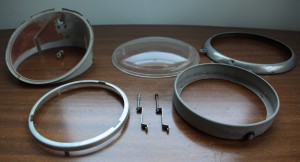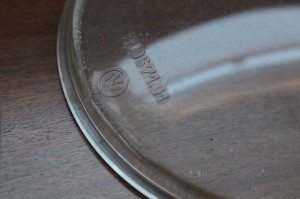Woke up at my usual time and wanted to investigate a mystery I had been wondering about. In identifying the bus of this year there are three critical pieces of info in the engine compartment (engine number, VIN number, and Chassis plate) and one in the cab (m-plate). There is also a chassis number in the cab, but that only was used
internally to vw and doesn’t line up with the VIN number at all. So these data points can be used to ensure that a bus is not hacked togeather from a bunch of different bus’ or a covered up stolen bus. So far I’d found and decoded the m-plate (see the first post on this blog), found the vin number that is stamped just to the right of the engine where the apron
meets the chassis and found that the engine number doesn’t exist on the replacement case that my engine has.
The only one of these datapoints that should be there that I hadn’t seen was the Chassis plate. For a 1963 it should on the right side of the engine compartment bulkhead. In photos of my bus’ engine compartment I looked around this area and only saw the voltage regulator. I looked on other bus’ and saw that their voltage regulator was put more to the right (closer to the wheel well) than mine. When going to bus fest I talked with VolksFire and looked over a lot of this 1960 panel (the shasta rollover bus) and saw that his was missing the chassis plate and so I was wondering if mine could be missing as well. On the train ride down to Fresno I read quite a few chapters out of the Idiot’s guide and saw that he lists the voltage regulator as being either on top of the generator or placed in the engine compartment. Seeing this I grabbed my photos again and looked to find the ones of the spare parts that the previous owner had in the bus, one of which was the old generator. The photo shows the original voltage regulator on it, so now I know why mine has a different placement. The real question was why did they mount it where the chassis plate was?
Looking in the bus near this area with my head lamp on I didn’t see anything like the chassis plate. Behind the voltage regulator was black paint and there was an odd backing plate under this paint, but I should be able to see some lettering through the paint and I couldn’t see much of anything. I got out the right sized ratchet to pull the
grounding strap, then the right size to pull the voltage regulator and
behind the voltage regulator was indeed some sort of plate. Using a
screwdriver I was able to remove the plate and it was indeed the chassis plate covered not with paint, but some sort of thick tar substance.
My Dad had some goof off (paint remover) and steel wool that I used to uncover the details on the chassis plate. It took a suprising amount of elbow grease to get the tar stuff off, but the plate did clean up nice with only one sheet metal screw drilled through it.
My goal beyond researching this plate was to do a full 3,000 mile tune up. I had read the chapter for the tune up the night before on the train, so it was still fresh in my mind. I also made a list of different parts that we’d need, so a trip to Sebring West was in order. We pulled a spark plug as well as a bad 8v fuse to take with us.
We also started going over the routine for checking the valve clearances, which are pretty important to having a healthy engine. We had a hard time figuring out the position of the different cylinders, but looked around enought to see that they are printed on the case.
In looking I may have found a part number for the case, which is madein Mexico. I’ll need to get the photo from my Dad, but the part number ended in 101-101A and it was stamped under the heads for the cylinders 3 & 4 (left side of the car). We pulled off the distributor
cap and checked out how to get the first cylinder to line up at top dead center (TDC).
This bus has an older crank pully than the ones that VolksFire had, which were marked with degrees off of TDC. This one has the 0 (TDC), 7.5 and 10 degree notches on it. When the crankcase pully is spun the first and third pistons reach the apex of their travel at the 0 degree notch and the second and fourth cylinder reach their apex 180 degrees
off of top dead center. Why they didn’t put a notch at 180 degrees beats me, so following John Muir’s advice I “grabbed a paint stick”(really a twig dipped in Whiteout) and marked 0 degrees. Using a plumbob that my dad has we were able to hang it from TDC lined up with the crank case and mark 180 degrees very acuratly. It took a lot of effort to get just right, but will be very useful in future valve jobs.
This also required taking off engine tin to get access to the bottom part of the crank pulley. The engine tin was really greasy and it gave me a good chance to look at the heater/fresh air system,which I’ll need to buy a new bus muffler for. I grabbed a few photo’s for reference while I had the tin out.
One of the items on my list was a tach-dwell meter and my Dad thought Kragen might have a tach dwell meter cheaper than other places, so we headed there first. The sales person said he’d just seen one at a yard sale, but didn’t carry one. He pointed us to Harbor Freight, but we were getting toward 4pm and Sebring wouldn’t be open much longer, so we headed there.
Sebring had a lot of stuff that I needed. I got the following:
1) Bosch spark plugs
2) Valve cover gaskets (empi semi cork ones)
3) points & condenser (John Muir recomends replacing both at once).
4) generator pulley
5) 8v & 16v fuses
6) fuel line.
While we were waiting in line the sales person, Rod, kept asking my questions to the guy behind me, who was about my age if not a bit older. With the fuel line he asked what year my bus was and I said 63. He asked where I got it and I mentioned that the previous owner was a fire-fighter and his grandfather was the original owner. He asked if it was a blue panel and I said yes. He asked how much I got it for and said he looked it over. He and my dad went outside and talked for a bit as I finished up the sale.
I met up with him outside where he was showing my dad his 67 squareback, with a roof rack that he proudly found for cheap. I asked him about any bus groups in town and he said that the Madera show was the only group he was involved with. It wasn’t a club with
memberships or anything, just a group of volunteers like NAG or most of the opensource user groups that I’ve been apart of and I like that. I’d like to talk with him a bit more about my bus to see if he knows anything more about its history.
We said goodbye and headed over to Harbor Freight since Sebring didn’t have a tach – dwell. Harbor Freight didn’t have one either, so my dad found a nice tarp and we took off. They also had different blasting medium, which will come in handy when I get to that stage. We got back and my Cousin Mike was there having roast beef dinner that my Mom had repaired. It was delicious.
After visiting with Mike, I decided to go treasure hunting and pulled out the passenger seat to see how the previous owner padded it out. There is burlap over the springs and possibly horsehair (coconut husk actually) with a large layer of foam on top of that. I can remove it, but it’ll take removing the large wire staples around the perimeter pulling out the foam and then re-stretching the leatherette to fit the seat. It shouldn’t be too hard just like all the other easy stuff that’ll “just buff out”. After looking over the seat I used it to
prop open the door as I removed the passenger kick panel and peaked behind it. There was a wrinkly old paper that I grabbed with my little claw grabber and a emblem clip that I left down there as it was hard to reach. There is some damage to the front kick panel and
it’s being held on with sheet metal screws (man this guy loves his sheet metal screws, must of had a whole box of them).
The driver’s side kick panel reveled nothing of interest except for the electrical components hidden behind it. There is also some slight damage to this kick panel as well. It would be nice to get some wood ones created for it by Josh Ganshorn (Abel & Baker wood work and construction).
After putting back the panels I grabbed a few razor blades and finished up the inside of the rear window. It cleaned up pretty nice and reveled some scratching on the other side that either was there before or we added last time I was in town. After cleaning them well
I went into the the cab and cargo area and got the divider panel’s window cleaned up as well. It had splashes of different paint on it as well as what looks like epoxy. I still need to look at the rough (epoxied?) spots to see if I can clean them up. Maybe steel wool or jeweler’s rouge.
At that point it was nearing midnight and I crashed for the evening. I’m wondering how these guys on thesamba.com get the energy to work on a bus all night, sleeping on site to drive bus’ out… oh wait energy drinks :)










